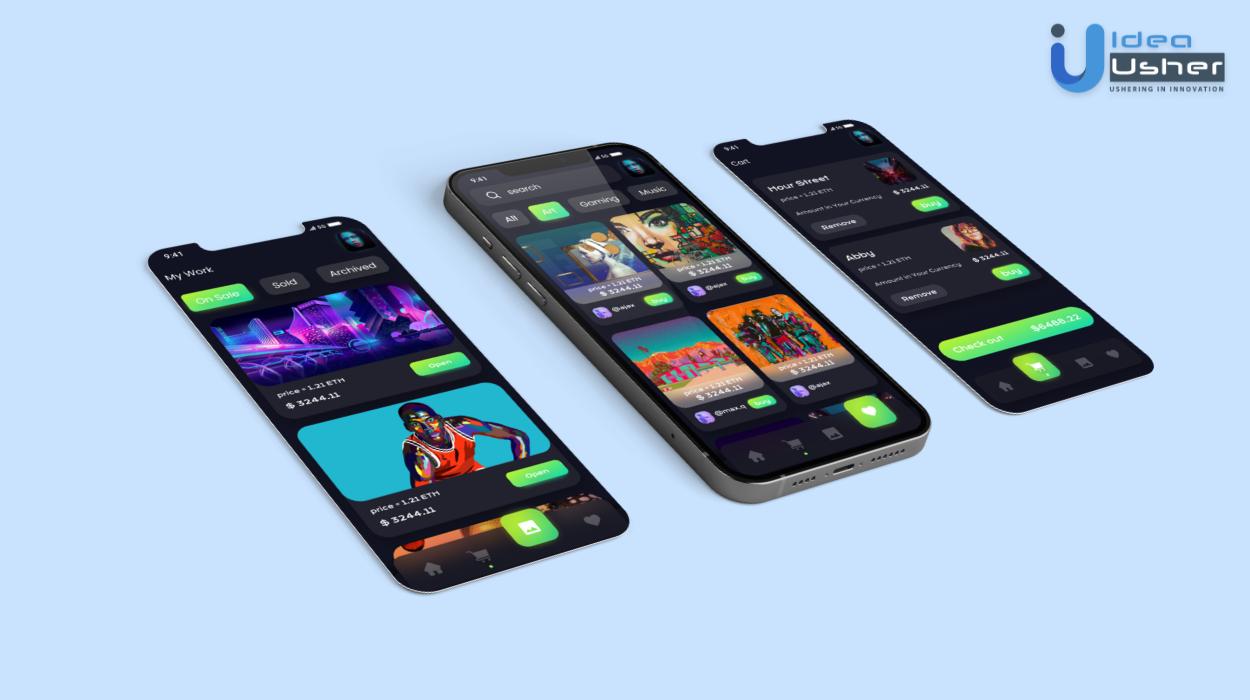Non-Fungible Token is undoubtedly the trendsetter in the modern digital market world. Recently, investors, creators, and people are involved in purchasing and selling digital assets as NFTs. Idea Usher experts bring an exciting insight to educate the readers. Stay with us in this blog to learn everything about how much does NFT Marketplace development costs. Additionally, we will also throw light on some critical aspects of NFT Marketplace development.
NFT development has surprised the world with enormous opportunities for the future. The immense rise of NFT and the heavy inclination of millennials have pushed forward the NFT owners and the marketplace. The marketplaces such as OpenSea are witnessing high revenue and a flood of funding.
What is an NFT Marketplace?
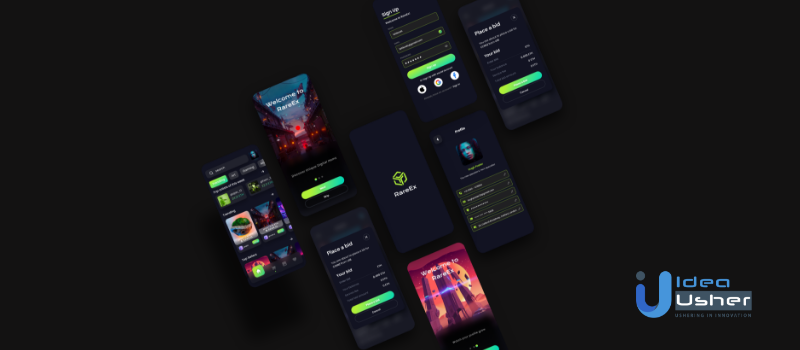
NFT is a unique digital asset or a product combined with a digital certification that can trace back to digital asset ownership. Additionally, Unlike fungible tokens (traditional currency), it is not possible to trade NFTs directly. It requires a unique platform called the marketplace.
Buyers can reach the marketplace like OpenSea and procure virtual products using cryptocurrencies such as Ethereum and BitCoin. Marketplaces issue a fixed charge upon the total transaction amount of acquired NFT.
Types of NFT Marketplace Platforms
NFT Marketplace platforms are primarily of two types:
- Niche peer-to-peer marketplaces: These NFT marketplace platforms aim to offer particular digital assets, i.e., assets belonging to a niche. An excellent example of a p2p NFT marketplace is Valuables. It is a platform where one can essentially buy and sell tweets (hard to believe, but true). For another instance, we can consider Glass Factory, where users can purchase digital holograms.
2. Universal non-fungible token websites: In Universal NFT Platforms, one can sell any kind of crypto assets. It can be anything from digital art to a domain. We very well know about some of the top Universal NFT platforms, Rarible, OpenSea, and Mintable.
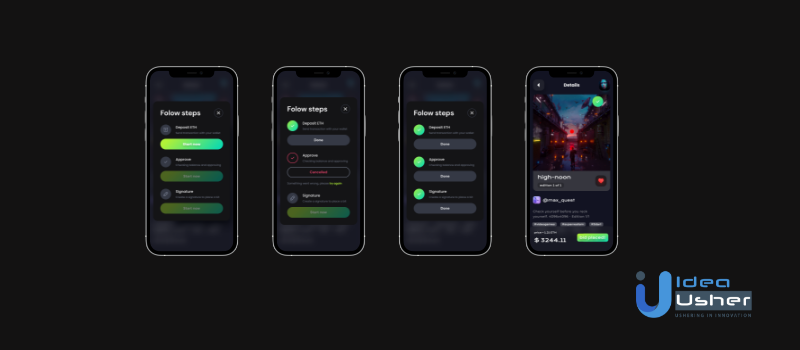
Which are the top NFT Marketplace platforms?
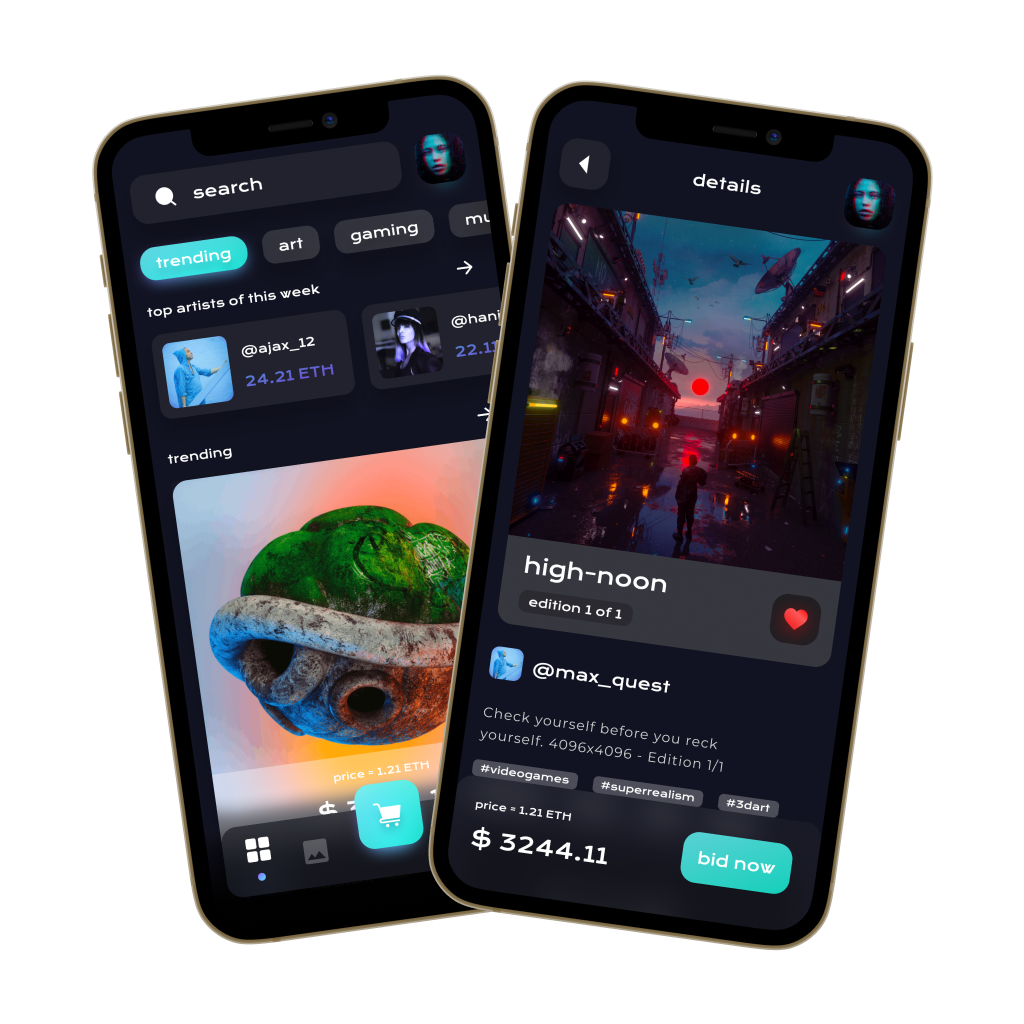
NFT marketplace development is gaining high popularity nowadays. NFT will surely bring in new customers in the coming years. Therefore, that can flourish the marketplaces with heavy sales and buys. Such a transactional platform offers a space to buy, sell and trade non-fungible tokens for Non-fungible token development companies. Here are some of the top NFT Marketplace platforms leading the race in 2021:
1. Opensea
Opensea is the very first and one of the biggest NFT Marketplace of the cryptocurrency world. The organization allows its users to trade in digital collectibles, gaming assets, and other blockchain-supported assets.
2. Rarible
Rarible is another immensely popular NFT Marketplace. It is a well-established platform that allows digital artists and creators to subject and monetize their created crypto assets. Additionally, Rarible is also a distributed network developed on Ethereum that allows trade by eliminating the middlemen.
3. SuperRare
SuperRare is a marketplace to store and buy/sell unique, exclusive digital artworks. Interestingly, each artwork (digital) is created and authenticated by an artist in the network. Further, it is tokenized as a crypto-collectible digital asset that sellers can own and trade.
4. Hoard Exchange
Hoard Exchange is an NFT platform that mainly focuses on revolutionizing the video game industry. The organization caters to its users by enabling actual ownership of virtual items and content using blockchain technology. Moreover, Hoard Exchange serves downloadable content.
5. Foundation
Foundation, termed as “Foundation.app”, is a platform facilitating live digital art auctions and NFT auctions. It is a top-rated platform that functions live bidding for numerous community artworks. Foundation is a straightforward and effortless to navigate suite. It is now a fancy destination for NFT artists as well as digital art enthusiasts. All types of users participate in (decentralized) auctions for a sequence of creative digital assets.
How Does an NFT Marketplace Work?
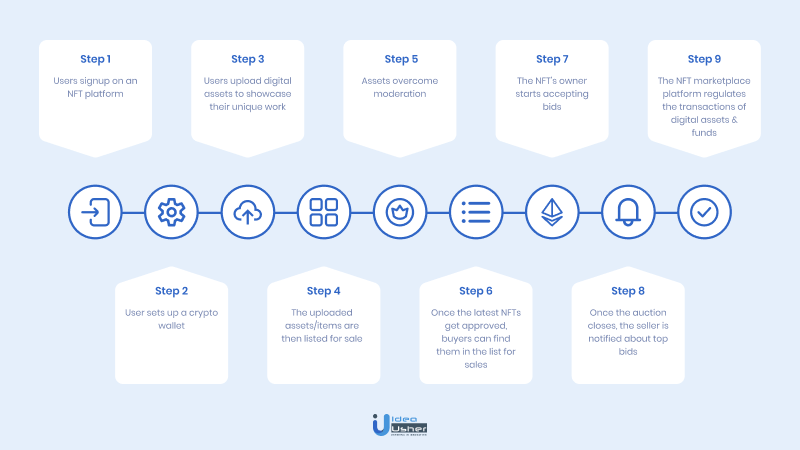
NFT runs on smart contracts. When a Non-fungible token development company releases a token, it contains unique information recorded in blockchain for providing immutability Share on X Usually, there is a standard user flow of all NFT marketplaces:
Step 1: User signs up/registers an account on the NFT marketplace platform
Step 2: The user is then required to set up a crypto wallet
Step 3: Now, we arrive at the initial NFT creation step. The user can upload a digital collectible (any asset that the user wishes to tokenize) to showcase their work
Step 4: While listing the asset for sale, a user has two options: setting a fixed price or auctioning the item and finally choosing a bid
Step 5: Assets pass the moderation
Step 6: Once the new NFTs are approved, potential customers can find them in the sales listings
Step 7: The NFT owner can begin with accepting bids
Step 8: When the auction ends, the platform notifies token owners about top bids
Step 9: The NFT Marketplace platform regulates and approves the transfer of digital assets and funds
What are the core features of an NFT Marketplace app?
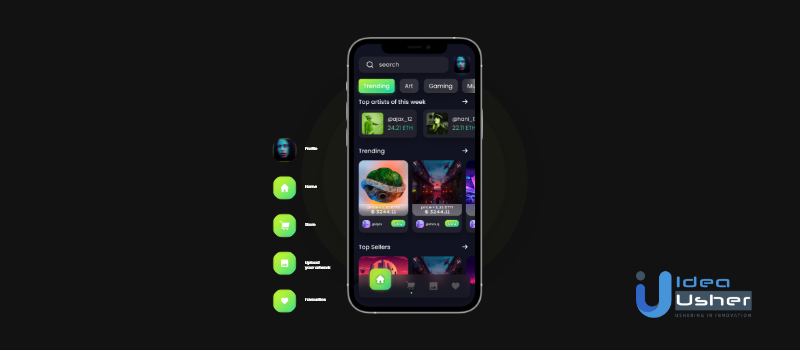
Here are some essential features which reflect the absolute idea of an NFT Marketplace app:
1. Storefront
The Storefront represents the dashboard or the landing page of an NFT platform. Additionally, it provides the users with information regarding the assets. The description may generally include:
- Asset details,
- Owner of the asset,
- Previous bids,
- Price history, etc.
2. Search functionality
An aspiring NFT platform must support a category division and management feature. It would essentially make it easy for the users to search for collectibles that they are willing to purchase.
3. Create listing
This functionality of an NFT marketplace is focused on the sellers. The platform should provide users the feasibility to create listings where they can add in their NFT details.
4. Auction and Buy
A productive NFT buying system is a must-have feature of the NFT marketplace development services. You should serve users with the option to enter bid amount, expiration date, and a watchlist showing details of the bid’s status.
5. Wallet
Your users will need to use wallets to pay, receive, and store NFTs as well as for cryptocurrencies. In connection to this, you can either add your own wallet in-app or integrate existing wallets inside the application to make the experience hassle-free.
While these are the must-have features of an NFT marketplace, there are a number of other features set as well, such as
- the ability to create NFTs,
- multi-payment gateway integration, etc.
- business owners have the option to merge NFT platforms, NFT crypto platforms, and NFT trading platforms – all in one space.
If we consider the wide variety of NFT marketplace features, it can be challenging to determine a price range. We advise that you contact our team of Blockchain developers and let them brainstorm, crosscheck and then share the price range with you.
How to build an NFT Marketplace App?
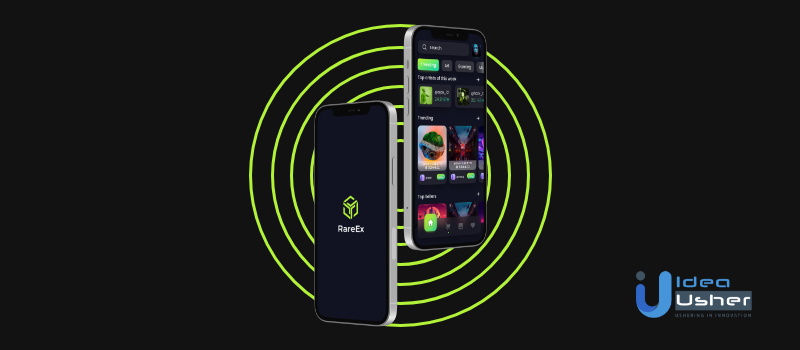
It is always easier to divide and develop the entire product into smaller stages when we build anything. Especially in the app development world, we layer down the product’s goals, and different professionals focus on their specializations. Moreover, app development (irrespective of the niche) is mostly divided into seven steps. Let’s find out how we define these layers and how we constructively come up with an efficient app solution.
Step 1: Define Niche
The first step to build a booming NFT marketplace is to make the user aware of the current market.
- A vertical market is simply where the supplier sells the products that satisfy the requirements of a particular target audience.
- While on the other hand, a horizontal market focuses on a wide variety of products/services simultaneously. Horizontal markets are very dynamic and require a lot of effort and investments.
Expert tip: Business enthusiasts should zero on the vertical market rather than the horizontal market.
Step 2: Define App Panels
Panels are designed based on the different types of users of an app. There are three types of users in NFT marketplace platforms:
- Buyers: users looking for digital artworks or other assets and willing to buy them.
- Creators: the artists creating and designing the digital assets, which further get tokenized as NFTs.
- Administrators: the admin of the NFT marketplace platform, who manages and runs the platform. The administrator is responsible for the right exchange of funds between sellers and buyers and the ownership transfer of crypto tokens.
Step 3: Documentation
The development process starts with project documentation. Whenever the question arises, how much does NFT marketplace development costs? The first factor is the documentation. It is a very crucial part of developing an application.
Documentation involves:
- framing the functional and non-functional requirements
- deciding on the user flow,
- features,
- quality aspects, etc.
It lays down the architecture of the software by encapsulating the various use cases and functionalities of the app.
Moreover, the core idea towards documentation is to frame a solution for all existing requirements and potential problems with the functionalities. Developers can’t remember all the requirements and client’s expectations. Therefore, documentation holds the key to an application’s successful development.
Step 4: App Prototyping

In the modern digital world with stiff competition all around, delivering an efficient product is not enough. Consumers now have more choices than ever. It is vital that organizations focus on delivering experiences rather than just a functional product/service. Here’s where UI/UX comes into the picture. The look and feel of your app matter more than they did before. Therefore, prototyping the UIs and screen mockups is essential before the app’s actual coding/development. Developers should not code the app till the client is satisfied with the prototype designs.
Step 5: Development Stage
In the development stage, the owner decides the type of framework relevant for the project. Developers also utilize Dedicated SDK ( Software Development Kit )to ensure rapid platform operations. Additionally, SDK enhances reliability and delivers good performance. Once the framework is chosen, then developers move on to the actual coding stage. Developers start implementing the functional requirements of the app that were documented earlier. The quality requirements or non-functional requirements are also met at this stage.
Step 6: Implement Token Generators
While arriving at the implementation stage, token generators create small contracts. You might be wondering, what on earth is a minor contract. It is nothing but a self-executing contract with a specific set of terms and conditions. Those T&Cs are mutually agreed upon by the seller and the buyer. Moreover, the agreement and the code exist across a distributed, decentralized blockchain network. This process’s core aim is to implement the NFT generation logic in the app.
Step 7: Test and Execute
Now, as with every app, testing is crucial. This stage assists developers in identifying bugs and fixing them. Additionally, software testing makes sure that the ongoing project meets the requirements of the target product. The core aspects making this step critical are that completely tested software provides security, reliability, and high performance.
How Much Does NFT Marketplace Development Costs?
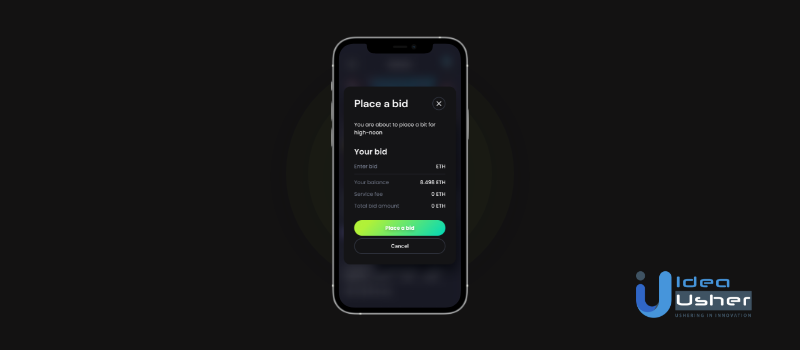
We now arrive at an exciting and tricky question, how much does NFT marketplace development costs?. However, in a nutshell, everything relies on the volume of work required. For instance, if you decide to use a ready-made solution that is ready to be used, the cost will be lower.
The same flow follows for the platform functionality. If your requirements arrive at a complex platform (a platform with dynamic features which haven’t been implemented before), you will have to invest more money in marketplace development.
We framed a table presenting the correlation between the functionality of an NFT marketplace and its cost for your convenience.
| Features | Time(hours) | Cost/hour ($15- $60) |
| UX/UI Development | 42 hours | $630 – $2520 |
| Authorization and Security | 72 hours | $1080 – $4320 |
| User Profiles | 42 hours | $630 – $2520 |
| Home page | 84 hours | $1260 – $5040 |
| Search and filters | 96 hours | $1440 – $5760 |
| Product page | 42 hours | $630 – $2520 |
| Reviews & Ratings | 48 hours | $720 – $2880 |
| Shopping cart | 48 hours | $720 – $2880 |
| Payments | 42 hours | $630 – $2520 |
| Notifications | 32 hours | $480 – $1920 |
| Etherium incorporation | 96 hours | $1440 – $5760 |
| NFT management | 96 hours | $1440 – $5760 |
| Inventory management | 42 hours | $630 – $2520 |
| Buyer panel | 64 hours | $960 – $3840 |
| Author panel | 132 hours | $1980 – $7920 |
| Admin panel | 85 hours | $1325 – $5100 |
| Total | 1063 hours | $15,995 – 58,020 |
Factors That Impact Your NFT Marketplace Development Cost
Creating an NFT platform from the ground up requires significant time, effort, and expertise in blockchain-based development. NFT development requires additional integrations to ensure its security, which increases the complexity of the platform. Here are some key factors that influence the cost of NFT platform development:
1. NFT Tech Stack
NFT Tech Stack The NFT tech stack plays a crucial role in cost assessment. The standard tech stack used by NFT developers includes blockchain platforms like Flow, Tazos, Cardano, and Ethereum, storage platforms like IPFS, Pinata, and FileCoin, NFT standards like ERC-1155 and ERC-721, and frontend frameworks like React, Vue, and Angular. The more sophisticated the tech stack, the higher the cost of development.
2. NFT Marketplace Niche
NFT Marketplace Category Niche The NFT marketplace niche you choose will also influence the cost of your NFT platform development. For instance, if you are developing a platform for collectibles, your platform needs to be more secure than an open app market. Some common NFT marketplace categories include:
- Open and Premium Marketplace: This is one of the most common NFT marketplaces, such as OpenSea. However, this type of marketplace has fewer features than closed ones.
- Curated and Non-Curated Marketplace: A curated marketplace is a friendly environment for authorized artists looking to sell their work, while a non-curated marketplace promotes both authorized and non-authorized artists, making it easier for users to sell.
- Collectibles Marketplace: This is the perfect marketplace for collectors who buy and sell various digital NFTs, such as NBA sports highlights for sports fans.
- Games Marketplace: The gaming industry is popular with NFTs, specifically for online gaming. Here, users buy, sell, and invest in various gaming platforms to attain advanced features, avatars, or levels.
3. NFT Development Team
NFT Development Team and Process Outsourcing your NFT project to a range of blockchain NFT experts who can implement a successful design, development, and testing plan is crucial. You will need a team of developers, designers, and blockchain experts who can work together to create a robust NFT platform.
4. Maintenance Cost
NFT Marketplace Maintenance Cost The maintenance and support cost of your NFT marketplace platform is necessary if you are looking to develop NFT solutions for the long run. Regular maintenance is essential to keep the platform up-to-date, secure, and free from bugs or glitches.
How can Idea Usher help to kickstart your NFT Marketplace Business?
Idea Usher serves as an ideal push for the development of multiple blockchain technology businesses. Additionally, our experience and innovation in blockchain can unlock exciting opportunities. We always thrive to offer a reliable solution for companies in the crypto world.
Our experts deliver an efficient building model. Additionally, they design your NFT marketplaces like OpenSea (as per the trend) and according to your business requirements. Our product development incorporates exquisite marketing strategies to kickstart your NFT marketplace. We help you compete with the market players and emerge as a new trendsetter in the market.
Here’s how our expert product building team looks like:
- App developers
- Quality analysts and testers
- UI/UX designers
- Experienced blockchain developers
- NFT experts
- Associates and managers
- Marketing professionals
Why should you hire Idea Usher?
Idea Usher has helped numerous NFT Marketplace app startups become
dominant players in the industry. We deliver versatile NFT Marketplace apps, effective marketing campaigns, and support and maintenance. Contact us now for a quote!
Wrapping Up
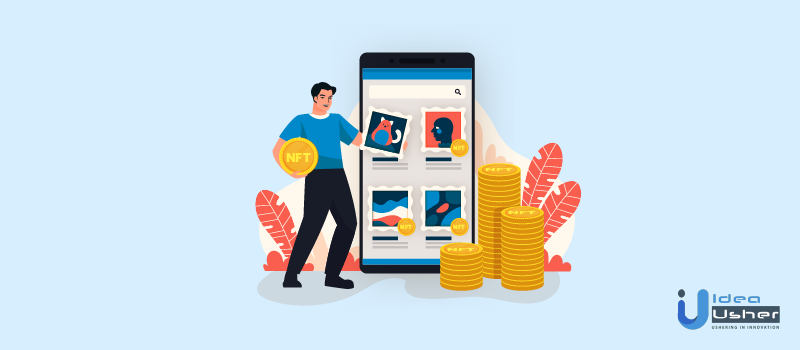
The Non-fungible tokens (NFTs) keep on ascending in exchanging volume inside the blockchain business. There are many promising marketplaces out there. However, the technology presently can’t seem to be created and introduced for a completely interoperable commercial center for allowing bother-free cross-chain NFT transactions between various blockchains.
Hopefully, you must know how to build an NFT Marketplace app and how much does NFT Marketplace development costs. Henceforth, you can try your hands on a lucrative NFT marketplace business. It doesn’t matter even if you have no app development and marketing experience! You can always look for comprehensive services from Idea Usher.
Here in Idea Usher, we offer the business visionaries with each of the latest functionalities imbued in the NFT marketplace development. Financial backers would now be able to make their own NFT marketplace with our help. We have professional designers who assisted considerable startups in NFT marketplace development. Get this chance to connect with us For more significant advantages in fostering your business development. Contact us now at [email protected] for a quote.
FAQs
Q. What are non-fungible tokens?
A. Non-fungible tokens are the next step in crypto as they enable trustless transactions on decentralized marketplaces. If you’ve been following crypto, you probably have heard of ERC-721 tokens. These tokens have an exciting property: they are not fungible.
Q. Will cryptocurrency be a lucrative business venture?
A. Yes. By 2050, over 9 million financial transactions will be digital. Cryptocurrencies exist online, and anyone can buy them from the entire world. It is regardless of their age or where they’re from. Now imagine how much money a business can make by venturing into it.
Q. Can Idea Usher help my business with NFT game development?
A. “Game development” is the next digital gold rush, and your business can get there first. We are already witnessing games, gaming costumes, gaming skins, and other in-app purchases as NFT gaming assets. However, cryptocurrency and blockchain technology has propelled game development further than we thought possible. Hiring with an agency like Idea Usher can help streamline your workflow, allowing you more time to develop brand strategy and market planning.
Q. How much time does an NFT app takes to develop?
A. The development of a non-fungible token application or an NFT marketplace wallet/ app takes around 45-50 days. Additionally, it depends on your requirements majorly.
Q. What is the difference between NFT, SFT, and DNFT?
A. NFTs are non-fungible tokens. They basically come with a digital certificate of ownership of each digital asset. NFT can be in many forms like digital artworks, gifs, videos, etc.
While on the other hand, ERC-1155 is a token standard developed by Enjin that can usually assist in creating both fungible (currencies) and non-fungible (digital cards and in-game skins) assets on the Ethereum Network
Distributed Non-Fungible Token (dNFTs) is an open-source standard that offers distributed ownership of NFTs in real-time applications on the EOS blockchain.
Q. Why is Cryptocurrency on the hype?
- The capital and opportunity to make a lot of money
- Volatility and excitement that comes with that
- News stories from within the crypto space
- Mainstream news
Q. How secure is cryptocurrency?
A. Blockchain and other cryptocurrencies are becoming more popular. One of the advantages of cryptocurrency is security. In 2021, you can securely store and transfer value without a third party’s help seems quite revolutionary.
Q. How to make users understand NFT better?
A. It’s quite simple to understand, NFT. However, people tend to overthink a little about it due to the inducement of ‘cryptocurrency.’ NFT marketplace is quite similar to an art exhibition, except for the fact that the platform can convert almost everything into NFT and auction it. Moreover, ownership and copyright can not be stolen from any owner.
Q. How long will NFT take to conquer the cryptocurrency market?
A. NFT system has already crossed significant benchmarks in the luxury and gaming industries and has enough potential to grow beyond these starting industries. The art industry will be an evergreen segment of the NFT market and is likely to reach maturity over a couple of years.
Q. Can we tokenize anything to NFT?
A. Yes, we can tokenize almost anything to NFT. Anything that a user is willing to sell and has a unique aspect to it. That will probably add up to its value.
